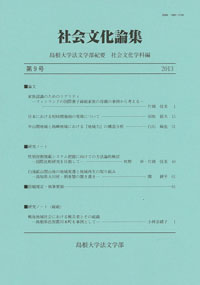島根大学法文学部
ISSN:1880-2184

number of downloads : ?
Use this link to cite this item : https://ir.lib.shimane-u.ac.jp/6861
Memoirs of Faculty of Law and Literature, Shimane University 5
2009-03-10 発行
1歳半の子どもに対する絵本の読み聞かせ方および育児語の使用と母親の信念の関連性
Effects of Beliefs Held by Japanese Mothers on Picture-Book-Reading Practices and Use of Baby-Talk Words
File
Description
It has been suggested that Japanese mothers frequently use baby-talk words for their children, and that the speech of Japanese mothers directed at their children during book-reading is more affection oriented and less information oriented in comparison to North American mothers. However, the reasons for these have not been clarified. Therefore, the relationships between maternal use of baby talk words and picture-book reading practices with their socialization goals, and beliefs regarding caregivers’ speech and picture-book reading was investigated.
Japanese mothers (n=62) of toddlers (age range: 17-22-months; 87.8% 18-19-months old) responded to questionnaires about use of baby talk words, picture-book reading practices, beliefs about caregivers’ speech to toddlers, beliefs about benefits of picture-book reading to toddlers, and maternal socialization goals for when their children would be 5-years old.
Factor analyses indicated the following factor structure: Autonomous-Relational Goal factor and Achievement Goal factor related to maternal socialization goals, Empathy Orientation factor related to beliefs about caregivers’ speech, Affectionate Function factor and Practical Function factor related to beliefs about benefits of picture-book reading, and Dialogic Reading factor and Acceptance-Oriented Reading factor related to book-reading practices. The descriptive analysis showed that Japanese mothers closely agreed with questionnaires that were highly loaded with autonomous-relational goals, empathy orientation of beliefs regarding caregivers’ speech, and affectionate function of benefits of picture-book reading. Path analysis indicated that maternal autonomous-relational goals concerning socialization were significantly related to empathy orientation of beliefs regarding caregivers’ speech.
The path analysis also showed empathy orientation of beliefs regarding caregivers’ speech was significantly related to use of baby-talk words, and acceptance-oriented reading and dialogic reading.
Japanese mothers (n=62) of toddlers (age range: 17-22-months; 87.8% 18-19-months old) responded to questionnaires about use of baby talk words, picture-book reading practices, beliefs about caregivers’ speech to toddlers, beliefs about benefits of picture-book reading to toddlers, and maternal socialization goals for when their children would be 5-years old.
Factor analyses indicated the following factor structure: Autonomous-Relational Goal factor and Achievement Goal factor related to maternal socialization goals, Empathy Orientation factor related to beliefs about caregivers’ speech, Affectionate Function factor and Practical Function factor related to beliefs about benefits of picture-book reading, and Dialogic Reading factor and Acceptance-Oriented Reading factor related to book-reading practices. The descriptive analysis showed that Japanese mothers closely agreed with questionnaires that were highly loaded with autonomous-relational goals, empathy orientation of beliefs regarding caregivers’ speech, and affectionate function of benefits of picture-book reading. Path analysis indicated that maternal autonomous-relational goals concerning socialization were significantly related to empathy orientation of beliefs regarding caregivers’ speech.
The path analysis also showed empathy orientation of beliefs regarding caregivers’ speech was significantly related to use of baby-talk words, and acceptance-oriented reading and dialogic reading.
Other Article
